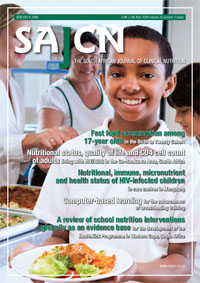Fast food consumption among 17 year olds in the Birth to Twenty Cohort
Keywords:
Fast food, nutrition transition
Abstract
Objectives Assessment of fast food consumption in urban Black adolescents. Design This current research was a descriptive cross-sectional study. Setting Subjects attending the Birth to Twenty (Bt20) research facility at the Chris Hani Baragwanath Hospital in Soweto, Johannesburg between September 2007 and May 2008 were enrolled. Subjects 655 Black subjects (51.1% females) were consecutively selected to participate from the larger cohort of Birth to Twenty (Bt20). Outcome measures Fast food item consumption and frequency of fast food outlet visits were assessed by interviewer administered questionnaire. Results Over a 7 day assessment period, participants consumed 5026 fast food items, with the most popular food item being an item known colloquially as a ‘quarter’. There were no gender differences in terms of preferences. Mean fast food intake was 8.1 (4.6) items and 7.2 (4.7) items per week for males and females respectively (p=0.01). A typical ‘quarter’ consists of 4 slices of white bread, chips, a slice of cheese, Vienna, polony and sauces. A macronutrient comparison between a ‘quarter’ and 3 commercially available fast food meals was undertaken, with the ‘quarter’ providing the most energy (5970 kJ) and being the least expensive (mean cost R9.16). Conclusion The average estimated daily energy requirement for a 17 year old is approximately 10,000 kJ, thus the ‘quarter’ may make a significant contribution to the daily energy intake. Further research assessing the role of fast foods in the provision of total energy and nutrient intakes in adolescents is required.
Published
2009-07-18
How to Cite
Feeley, A., Pettifor, J., & Norris, S. (2009). Fast food consumption among 17 year olds in the Birth to Twenty Cohort. South African Journal of Clinical Nutrition, 22(3), 118. Retrieved from http://sajcn.co.za/index.php/SAJCN/article/view/302
Issue
Section
Original Research
Material submitted for publication in the South African Journal of Clinical Nutrition (SAJCN) is accepted provided it has not been published elsewhere. Copyright forms will be sent with acknowledgement of receipt and the SAJCN reserves copyright of the material published.
The SAJCN does not hold itself responsible for statements made by the authors.


